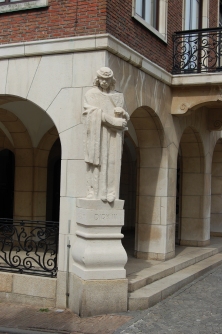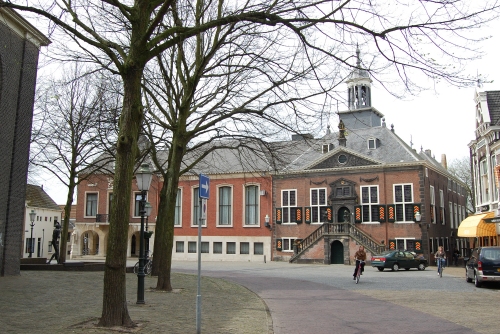The Battle of Vlaardingen (1018)Based on an article originally published in Dutch: Nieuwenhuijsen, K., De Slag bij Vlaardingen (1018), Terra Nigra 176, 2010, p. 32 - 50. (1) English version: January 2011 (version 1.0); February 2011 (version 2.0) Dutch version: www.keesn.nl/vlaard/index.html IntroductionOn the 29th of July, 1018, the Battle of Vlaardingen was fought. The German emperor sent an army towards western Frisia to subdue the rebellious Count Dirk III. However, the imperial army was defeated by the Vlaardingers and fled in panic. This is an interesting event because a superpower of the time was vanquished by a - theoretically - weaker opponent. Also, it is an important milestone in the development and the independence of the county of Holland. Despite the fact that it was a spectacular and prominent feat of arms, the Battle of Vlaardingen is not very well known, even among the Dutch. Historians differ on how and exactly where it happened. The aim of the present article is to reconstruct the events from the year 1018, based on the original written sources from that period and on archaeological findings. The often confusing tales from historiographers from later centuries will also be discussed. The sourcesSeveral medieval authors have described the events in Vlaardingen in 1018, but usually only gave scant details of the battle. Unfortunately, this is the case for many early medieval battles: the chroniclers were clerics more fond of moralistic expositions than of providing any military details. In the case of the Battle of Vlaardingen, however, there are a few exceptions. The monk Alpertus of Metz wrote an account which, by medieval standards, was very elaborate and detailed. In the Chronicon of Thietmar, bishop of Merseburg, and in the Cambrai Chronicle we also find, beside a lot of devout moralizing, some factual information. (2) These three works were written independently of each other, all around the year 1020. By combining the information from these texts, it is possible to reconstruct a probable overall picture for the events in 1018. Apart from these three contemporary sources, many other medieval writings that mention the battle or its participants have been consulted. Also, recent archaeological discoveries that shed a new light on Vlaardingen in the 11th century, have been considered. Political backgroundIn the early Middle Ages, Frisia comprised much more than just the present Dutch province of Friesland: it was the coastal area from Flanders towards the Danish border. Dirk III was count of West Frisia: today the provinces South and North Holland. The name ‘Holland’ was first used in the year 1101. Frisia was part of the German Empire, then known as the Holy Roman Empire. The emperor at that time was Henry II (1002 - 1024). His dominion covered what are now The Netherlands, most of Belgium, Luxemburg, Germany, Switzerland, Austria and northern Italy. Since the emperor could not be in all those places at the same time, he gave lands in fief to numerous vassals. The north-western part of the empire, Lower Lotharingia, was ruled by Duke Godfrey of Verdun. Frisia, the most peripheral part of the duchy, fell under the office of Adalbold, bishop of Utrecht, and under Dirk III, to whom the coastal defence in the west had been delegated. Count Dirk had his power base in Vlaardingen, along the banks of the river Merwede, where it merged with the river Maas. The area consisted of peat moors, inhabited by Frisians who were gradually reclaiming the boggy land by building dykes and digging ditches. Dirk’s grandfather, Count Dirk II, had received a ‘wilderness regality’ from the German king, which allowed him to cultivate lands north of the Merwede, between the rivers IJssel and Lier. Although the counts held the county in name, their Frisian subordinates continually caused them trouble. In 993, they killed Arnulf, successor to Dirk II and father of Dirk III, and in 1005, Henry II had to come to the aid of the young count Dirk III to establish his power. Henry had been called for help by Liutgarde, mother of Dirk III and sister of Cunigunde, Henry’s spouse. With the help of his uncle, Dirk managed to subdue the Frisians and to make them liable to pay taxes. (3) The causes
There were two reasons why Emperor Henry II organised his expedition against Dirk III, Firstly, the count forced the sailors who passed by on the river Merwede to pay a tribute. Secondly, he had illegally occupied lands in the region.
The traders from Tiel complained to the emperor about Dirk’s illegal practices. It hindered their trade with England and also kept English traders from sailing to Tiel. Thus, the count endangered commerce and the tax incomes of the emperor. Henry decided that the route between Tiel and England had to be cleared. Many historians describe Dirk’s activities as an illegal toll, although none of the original sources mentions a toll (teloneum) anywhere, only the payment of a heavy tribute. Imposing a toll was a privilege granted by the king or the emperor; the percentage of the freight that passing sailors had to pay was specified. Poelman demonstrated that no toll was charged in 1018 along the Merwede, but that Dirk and his men simply committed “piracy and privateering”. (4) Poelman found out that the word ‘toll’ first appeared in the Rymchronyk. This is a famous forgery, attributed to a Klaas Kolyn, a monk from Egmond who allegedly had put the history of Holland into verse in the 12th century. In reality, this Klaas Kolyn never existed and the verse chronicle was in fact written around the year 1700. (5) Initially, people believed this verse chronicle to be genuine. In 1745 it was provided with historical annotations and published officially by Gerard van Loon. The Rymchronyk says “dat men voert hive, op licht en zwaer mangelinch en vrachte, ti bi dage of bi nachte die ade op- en nedervoer” (that one charged, on light and heavy merchandise and freights, that by day or night sailed up or down the water). In his comments, van Loon made this into “a toll demand, later to be known as staple right ”. (6) The authoritative historian Jan Wagenaar (1709 - 1773) adopted this (and many other profundities from the Rymchronyk) in his History of the Fatherland: “Hy deedt er tollen heffen van alle waaren, die den stroom op en afgevoerd werden” (Dirk III had tolls imposed on all goods that were transported up and down the river). (7) Afterwards, Wagenaar admitted that he had been fooled, and subsequently none has seriously believed the authenticity of Klaas Kolyn. (8) Nevertheless, and despite Poelman’s study, the word ‘toll’ has persisted in relation with the battle of Vlaardingen. (9)
Tolls or not, the question seems academic since either way the sailors had to cough up. Still, it would make a difference to the merchants since a percentage imposed by an official authority could be calculated in beforehand, and was obviously preferable to falling victim to the capriciousness of a band of robbers. The latter state of affairs led to great indignation and, eventually, harsh measures.
Dirk III’s charging of tolls is often named as the main reason for Emperor Henry II’s punitive expedition. However, Dirk’s illegal occupation of territories in the ‘Merwede forest’ may have been even more important. Part of the area between the rivers Lier and IJssel was Dirk’s lawful property, because his grandfather had received it in 985 from King Otto III. However, other parts of the same region were claimed by the bishop of Utrecht. The bishoprics of Liege, Trier, and Cologne as well as several abbeys also had possessions in the region. (10) Count Dirk had had occupied the whole area, he had even built a castle there, and, worst of all, he was selling concessions for land reclamations to the local Frisians. The reclamations had started only recently (probably by the end of the 10th century) and formed a new and interesting source of revenues for the authorities. For Bishop Adelbold, this may have been the main reason to attack Count Dirk. (11)
In the year 1005, Henry II still supported his nephew against the Frisians, but now they stood against each other. This does fit a pattern in that during the 11th century there were several conflicts between bishops and counts where the German emperor invariably sided with the bishops.
(12)
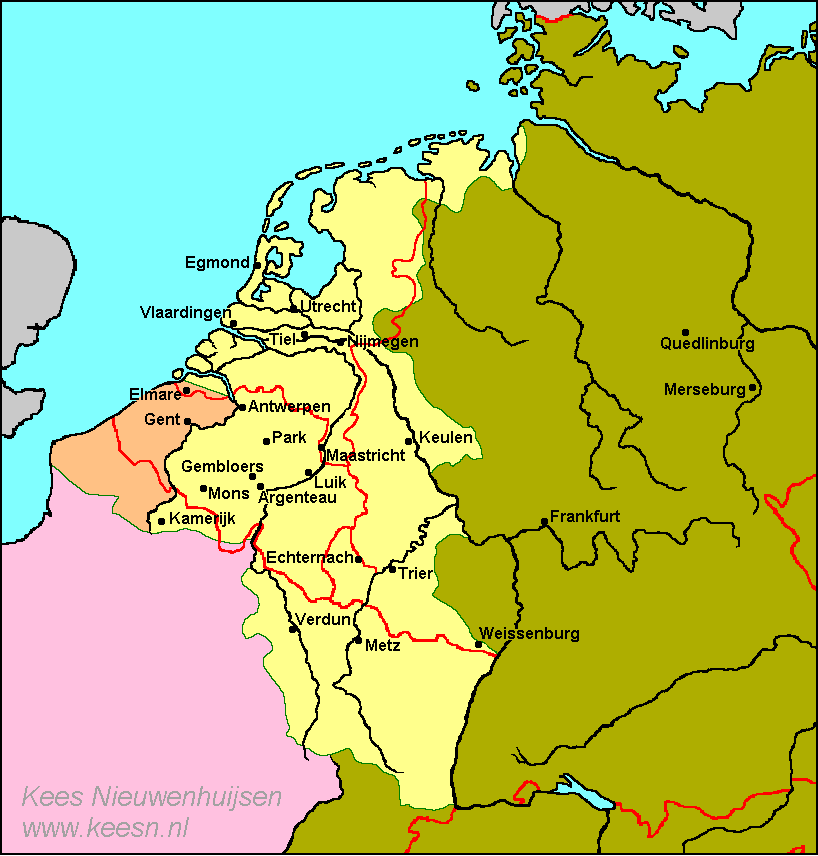 Figure 1. North-west Europe around the year 1000. The duchy of Lotharingia is coloured yellow; the borders are based on Droysen & Andree (1886). The county of Flanders (west of the river Scheldt) belonged to the West-Frankish kingdom. The Dutch coast line is based on Mostert (2002, p. 152). Modern national boundaries are indicated in red. The preparations for the expeditionAt Easter 1018, Emperor Henry II summoned a Reichstag in Nijmegen. He listened to the complaints of the merchants from Tiel and the Bishop Adelbold of Utrecht. Henry decided to mount a punitive expedition against the rebellious Count Dirk. Within a few months, an army would be assembled in Tiel, the most important port in the Low Countries. The army would sail west, along the rivers Waal and Merwede, to Dirk’s stronghold in Vlaardingen. From Thietmar’s chronicle, it can be inferred that Dirk III himself was also present at the Reichstag, and that he attempted to stop the plans, but without success. In any case, Dirk knew what was coming. The emperor assigned Bishop Adelbold of Utrecht and Duke Godfrey to organise the expedition. Godfrey of Verdun, duke of Lower Lotharingia, was the second most powerful man in the north-west of the empire, after the emperor. From the Vita Balderici it appears that he could order other dignitaries, such as the bishop of Liege, to supply troops.
Godfrey had already conducted several military operations. In 1013 he fought at Hoegaarden, together with Bishop Balderic of Liege, against Lambert the Bearded, the rebellious count of Louvain. That battle ended in a bloody defeat for Godfrey. Two years later he took revenge in the Battle of Florennes, where Lambert was killed. In 1017 Godfrey defeated Gerhard of Metz, another rebel count.
(13)
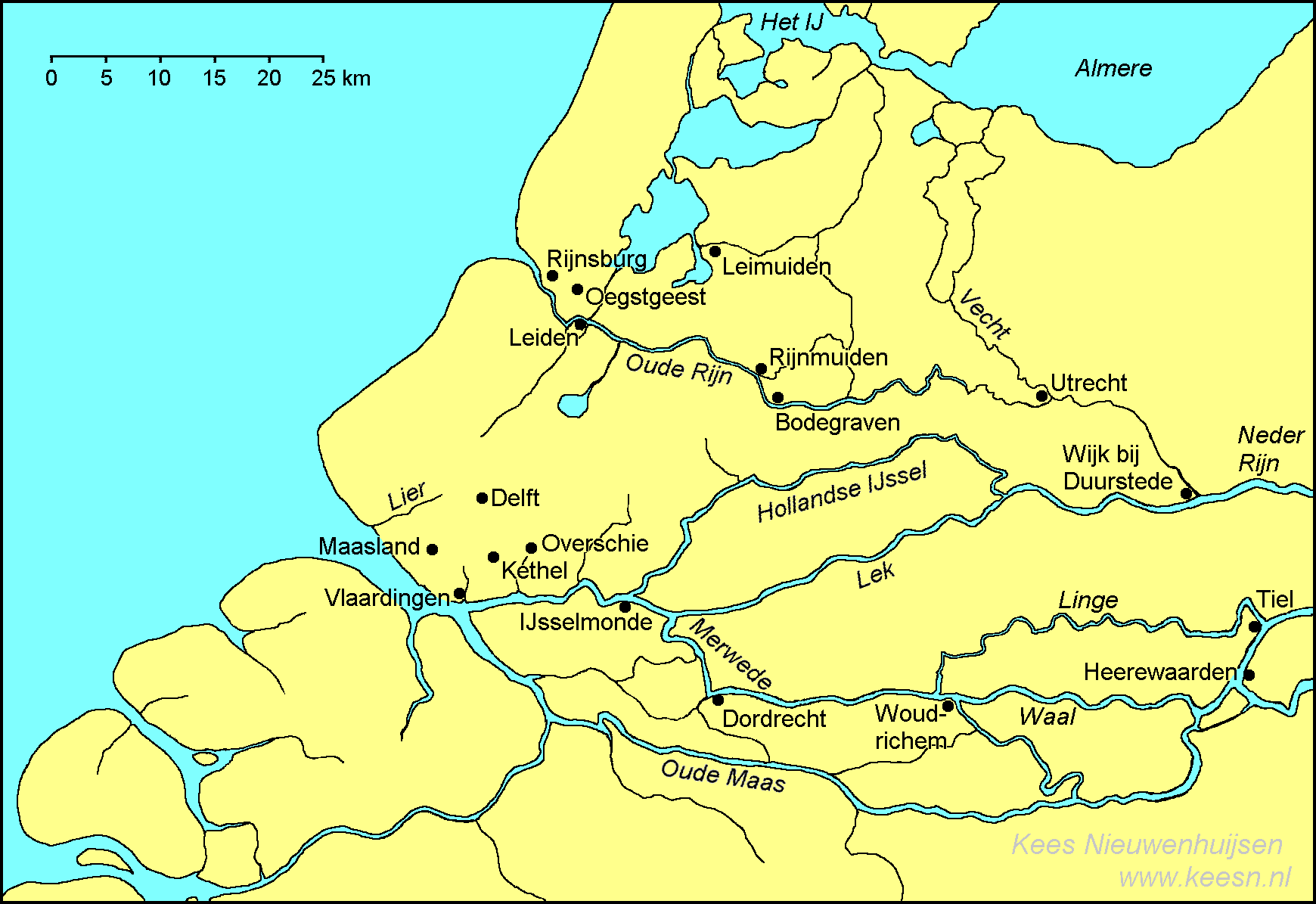 Figure 2. The centre and the west of The Netherlands in the 11th century. After Henderikx (1997, p. 104) and Mostert 2002, p. 152). Apart from the experienced professional soldier Godfrey and Bishop Adelbold of Utrecht, three more bishops and their troops were involved in the venture: Balderic II of Liege, Gerhard of Cambrai and the Archbishop Heribert of Cologne. All in all, the ‘German’ army actually came mainly from Utrecht, Belgium and northern France. The bishop of Utrecht, Adelbold, personally took part in the expedition, but it is unclear whether he merely led in prayer, or if he also acted as military commander and even wielded a sword. Thietmar recounts how Adelbold escaped the scene just before everything went wrong. The three main written sources do not explicitly mention troops from Utrecht, but it is unlikely that the bishop would have gone on his own. At the very least he had his own household, which would include milites. From the Miracles of Saint Walburg in Tiel (ascribed to Alpertus) it can be inferred that Tiel was one of the places where he recruited his men. Maybe the Utrecht contingent was not mentioned, because it retreated at an early stage and thus did not suffer serious losses. Bishop Balderic II of Liege also supplied troops, and he also participated personally in the trip to Vlaardingen. Shortly beforehand, he had a new crypt constructed under the Basilica of Our Lady in Maastricht, which had collapsed on the day of his departure. This turned out to be a bad omen, because on the way downriver with the imperial fleet from Tiel to Vlaardingen the bishop fell ill. At Heerewaarden he left his ship and he died on the very day of the battle. Bishop Gerhard of Cambrai was not present in Vlaardingen: the Cambrai Chronicle relates that he stayed in his bishopric and that he was not aware of the proceedings on the battlefield. Warriors from his diocese did participate, and many of them perished. (14) According to the Cambrai Chronicle, the archbishop of Cologne had also been summoned to provide troops. He is not mentioned any further in relation with the battle, so probably he was not present in person. The size of the armiesThe Cambrai Chronicle states that in Vlaardingen “a thousand have put even twice ten thousand to flight ”. This would imply that the emperor had sent 20.000 troops. However, this is only a literary quotation from the Bible (Deuteronomy 32: 30) which cannot be considered a realistic indication for the actual numbers on the battlefield.
According to Thietmar, more than three imperial legions were killed.
(15)
The question is: what number of soldiers comprised a legion? The sizes varied in Roman times, from 3000 to even 6000 men, and in the latter days of the Roman Empire legions were units of only 1000 men.
(16)
Depending on the definition, Henry II’s army may have counted between 3000 and 20.000 warriors. Van Bentum postulates that Thietmar meant a legion to be a unit of about 1000, which would imply that the strength of the whole army would have been at least 3000 men.
(17)
Count Dirk’s army must have been considerably smaller: the Cambrai Chronicle indicates a vast disparity between the two sides, and Alpertus qualifies the imperial army as enormous (“immensam multitudinem”).
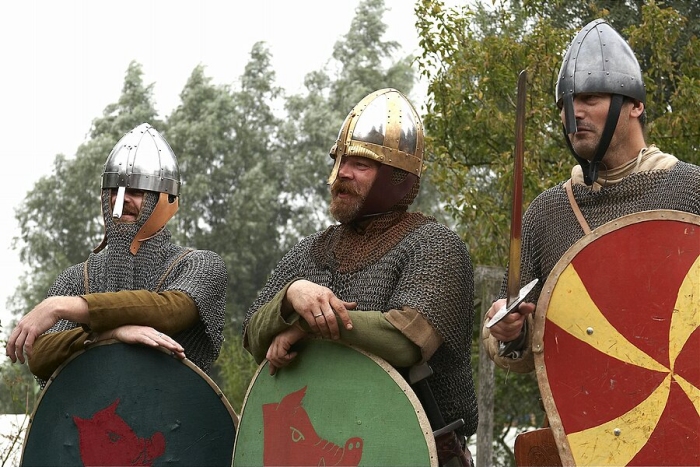 Figure 3. Re-enactors depicting 11th-century warriors. Photo: Kropot. There have been many discussions among historians about the sizes of early medieval armies. The contemporary sources rarely provide any specific numbers, and if they do, these are often implausible. It seems as if the authors did not care much about such earthly matters as dates and numbers. Based on the limited data available, Verbruggen suggests that around the year 1100, armies usually comprised a few hundred warriors, up to 4000 at the most; this assessment has been adopted by many historians. (18) Compared with these numbers, an army of 3000 men would have been rather large, but not exceptional. However, it remains uncertain whether this is a reliable representation of reality. Thietmar may have used the term ‘legion’ only to refer to the three major contingents (Utrecht, Liege and Cambrai), without implying a particular number. Data from other periods may help to identify what number would have been plausible, in Vlaardingen in 1018. Egil’s Saga describes the landing of a band of Vikings in Frisia, about 956 AD. They were faced by an army of 300 Frisians. (18a) Around the year 1100 the bishop of Liege had 700 armed horsemen at his disposal, and the count of Louvain could deploy 200 warriors. (19) In 1018, troops were supplied by four bishops and possibly a few counts. Their overall military force may have numbered 3000 men, but the question is whether they would have deployed all their men. In the 14th century, the armies of the counts of Holland numbered dozens or hundreds, sometime exceptionally rising to 2000. (20) In the 11th century the numbers must have been lower, since the county was less densely populated and there were as yet no major towns. Based on the above considerations, Dirk III may have had a few hundred men at his disposal. It seems overdone for the emperor to send 3000 professional soldiers against them: a number of about 1000 imperial warriors seems more likely. The course of the battleThe three 11th-century sources each give their own account of the course of the actual battle. Alpertus’ report is most comprehensive and detailed. It recounts how the fleet with the imperial army drifted down the river and moored at Vlaardingen. After disembarkation the army marched towards Count Dirk’s castle. The locals, who had seen the fleet approaching, had withdrawn within the castle and “on higher grounds”. Initially, Godfrey lined his men up around the castle, but then he ordered them to march towards a flat field, because it would be difficult to cross the ditches that were dug all over the place. (21) During this manoeuvre, even before a blow had been exchanged, someone suddenly cried out that the duke had been killed, upon which panic broke out. The imperial warriors hurried back to their ships, which had been moved to the middle of the stream by now, because of the lowered tide. They sank away in the soggy river bank or they drowned. Meanwhile, the “robbers” in the castle gestured and shouted towards the Frisians that were on the higher areas, that they should come forth now and attack the survivors from the rear. The fleeing soldiers were finished off with javelins. Only towards the end did Dirk III appear: he rode out of the castle, with a few retainers. They hurried towards Duke Godfrey, who was still alive and fighting, but had been cornered by the Frisians. Thanks to Dirk’s intervention the duke was not killed. Dirk captured Godfrey, and took him to his castle. This ended the battle. Thietmar tells a more concise tale, in which he mentions an ambush: the Frisians unexpectedly appeared from all sides and wiped out the imperial army. Thietmar also indicates that there were warriors who drowned in the river. The Cambrai Chronicle mentions, like Alpertus, the panic-monger who suddenly shouted “flee, flee” and the mass flight, but states this occurred when a fight between the two armies was already going on. Eventually, Duke Godfrey was hemmed in from an ambush and he was captured. So, Duke Godfrey survived the battle. Both Alpertus and the Cambrai Chronicle emphasize his courage: he did not run, but kept on fighting till the end.
The three sources all wail profusely over the miserable defeat suffered by the imperial army and the uncountable number of casualties, while the losses on Dirk´s side were minimal or even nil.
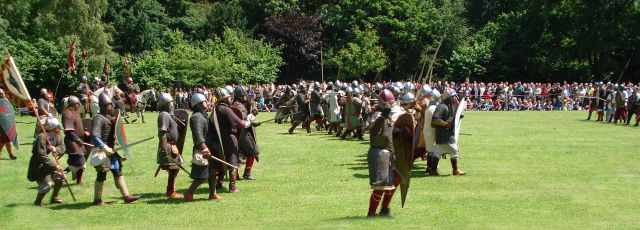 Figure 4. Re-enactment of the Battle of Vlaardingen on 14/15 June 2008 in Vlaardingen. Photo: Provinciaal Historisch Centrum Zuid Holland. The locationThe early medieval chronicles do not make clear exactly where in Vlaardingen the events took place or which manoeuvres the forces made. Three modern authors have attempted a reconstruction: Hoek, de Graaf, and de Ridder. Rotterdam’s city archaeologist Hoek places the battle three kilometres west of Vlaardingen, around the present municipal boundary with Maassluis. He argues, that a fleet landing near Vlaardingen itself would have been impossible because the settlement was built along an outside bend of the river, on deep water. Count Dirk III was in his castle which, according to Hoek, was situated even further to the west, in Maasland. The conflict became known as the Battle of Vlaardingen due to the fact that Vlaardingen, as a trading place, had more international fame than the larger settlement of Maasland. (22) Hoek’s reconstruction has been refuted by de Graaf, who argues that exchanging signals between the Frisians (in Vlaardingen) and the castle (six kilometres to the west) would have been impossible, and by Halbertsma and de Ridder, both of whom substantiated that Dirk III did not have a castle in Maasland. (23)
De Graaf places the castle in the middle of Vlaardingen. He assumes that the imperial troops disembarked directly south of the town. This seems logical: it would be the shortest route to their goal. However, the continuation pictured by de Graaf is less convincing: in his view, the final combat would have taken place about two kilometres to the east, in the Babberspolder. For that, both armies had to cross the Vlaarding (the creek running north-to-south, just east of the settlement). De Graaf gives no clear evidence for that manoeuvre.
(24)
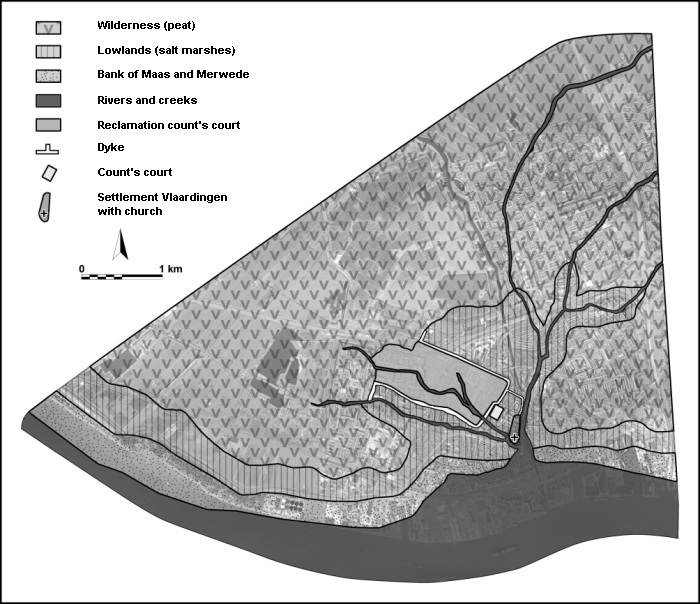 Figure 5. Detailed map of Vlaardingen and surroundings in the 11th century. The map is superimposed on a map of modern Vlaardingen. In the Middle Ages, the river flowed closer to the church hill than today. Source: de Ridder (2006). According to the latest views from Vlaardingen’s town archaeologist Tim de Ridder, the movements of the troops, the actual battle, and the flight, all occurred in the present Vettenoordse polder: a limited area, measuring about 500 x 500 metres, west and south of the church hill.
De Ridder suggests this church hill in the centre of Vlaardingen as the most obvious place for Dirk III’s castle. From this spot one has a view over the river Merwede, the port, the count’s farmstead and the surrounding area. A splendid strategic position.
(25)
In the early 11th century, the church hill was a natural mound along the bank of the Vlaarding. A small church stood on top of it. After 1050, the mound was gradually increased in height, upon which the present church hill evolved. The biggest heightening was done in the middle of the 12th century, for the construction of the new church. Since the 12th century, the major part of the mound is occupied by Vlaardingen’s ‘Great Church’.
(26)
In January 2007, ground radar and tracer investigations revealed a circular shape, a few metres below the church floor, with a diameter of 27 metres. The material the ring was constructed with is unknown. Because of the location (the church has been built straight across the ring), it is hard to carry out any further investigations. The precise age of the ring is also unknown, but it must date from before the major heightening of the church hill in the mid-12th century.
(27)
It is tempting to regard this discovery as the remains of a ring castle, built around the year 1000 by Count Dirk III.
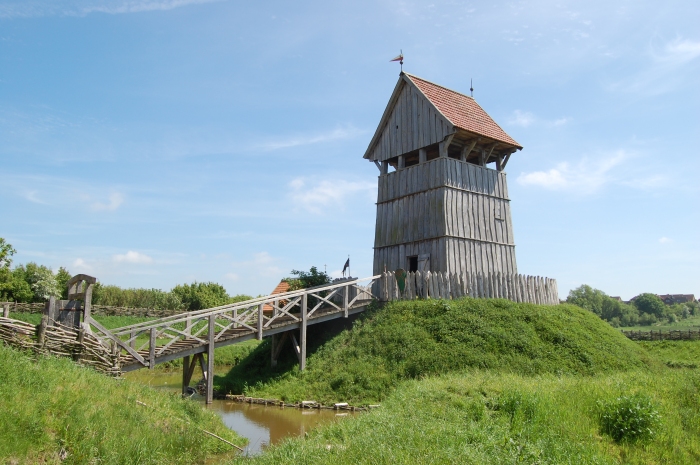 Figure 6. The Turmhügelburg in Lütjenburg (North Germany) is a reconstruction of an early medieval castle. The diameter of the paling is circa 12 metres, the mound measures 25 to 30 metres. Similar castles may have been built in The Netherlands in the 11th century. Photo: Kees Nieuwenhuijsen. De Ridder agrees with de Graaf, that disembarkation took place directly south of the town. According to de Ridder’s view, Dirk III took refuge in his castle on the church hill, and the Frisians retreated in and possibly also around the count’s farmstead, some 300 metres further north-west. Archaeological research has revealed two creeks or canals, running west-to-east between the landing spot and the farmstead. In order to do battle with the Frisians, Godfrey and his men had to cross these two streams. During the manoeuvres to find a good crossing place, panic broke out. At that moment, people in the castle shouted and gesticulated to the Frisians in the farmstead (the higher ground) to attack the fleeing opponents from the rear. (28) It must be stressed that this reconstruction is hypothetical and based on a number of assumptions. The presumed location of the castle has not been proven, and it is not certain whether the farmstead is meant by the ‘higher grounds’. (29) Still, the course of events as depicted by de Ridder seems to be the most plausible so far. “Flee, flee!”One of the most remarkable aspects of the Battle of Vlaardingen is the fact that a professional army suddenly panicked, when no actual hostilities had as yet been exchanged. At least, this is the picture that emerges from Alpertus’ account, where the panic among the imperial troops is described as occurring before the Frisians enter the stage. Alpertus says that the soldiers fled while no one was after them, and that they were killed before they had even drawn their own swords. This course of events contradicts Thietmar and the Cambrai Chronicle: they both mention a fight that was already going on before the flight. Incidentally, Alpertus also gives an indication that the fight had already begun: “suddenly someone yelled that Duke Godfrey, in the advance guard, being cornered by an attack of the Frisians, had fled the battle scene”. The latter part of this rumour was false, Godfrey stayed and bravely resisted the enemy. The former part could have been true, and it could point to the same ambush mentioned by Thietmar and the Cambrai Chronicle. The imperial army could have been surprised by a Frisian attack from a hiding place, upon which a part of the army (but not the advance guard with Godfrey in it) panicked and ran away. Then followed the signals from the castle and the job was finished by the Frisians from the farmstead. Presumably, the Frisians, with their lighter equipment and their familiarity with the terrain, had less trouble crossing the streams than their heavily armoured opponents. Where could the Frisians have mounted their ambush? The flat and bare tidal marshes to the south of the church would not have provided any cover. It is more likely that the Frisians were hiding behind the dykes built parallel to the two streams, west of the Vlaardingen settlement. Maybe they surprised the imperial army while it was crossing the first stream (the Poeldijkse Watering). If a few narrow planks or improvised bridges had to be used for the crossing, it may have taken a while before the whole army had reached the other side. A moment when the front guard already had crossed, and could not be assisted by the main force, would have been ideal for a surprise attack. A somewhat similar situation occurred in the year 939 at Andernach, where a small band of warriors took advantage of the situation, and defeated a stronger opponent. The larger party consisted of two dukes, Everhard and Giselbert and their armies, who raided the surroundings. King Otto I sent out the Counts Konrad and Udo, with a much smaller force, to stop the rebellious dukes. Because of the odds, the two counts dared not attack, and instead stealthily followed their enemies. At Andernach, Everhard and Giselbert’s army crossed the river Rhine. This had to be done in stages, with a few barges that had to back and forth several times. Eventually, only the army leaders and some retainers were left on the eastern shore, awaiting their turn. At that moment, Konrad and Udo launched their attack. The two dukes were killed, while their main force could do nothing but look on from the other side. (30) It may be, in Vlaardingen in 1018, that a similar opportunity arose when a small portion of the imperial army, including the leader, stood on one side of the water, while the main force was still on the other side. This situation would have been overlooked from the castle, and at the opportune moment the Frisians could have been directed to come forward. The Frisians would then have overpowered the vanguard, and the remaining imperial warriors would then have panicked and run back to their ships. Again, this is a hypothetical reconstruction, but it takes into account all three contemporary sources, and it explains the apparent contradictions between them. The aftermath
After the battle, the opponents hurried to make peace again. Duke Godfrey was released promptly, and he arranged a reconciliation between Bishop Adelbold and Count Dirk III. Both parties probably realised that the defence of the Frisian coast against possible Viking attacks was more important than the quarrels between themselves. Thietmar says: “There was no more mighty defender for that region, in case another more grisly enemy would rise”. Although the Vikings last visited the Low Countries in 1006 and 1009, they continued to raid England for several years after that.
(31)
So it is possible that in Frisia in 1018 their threat was still felt.
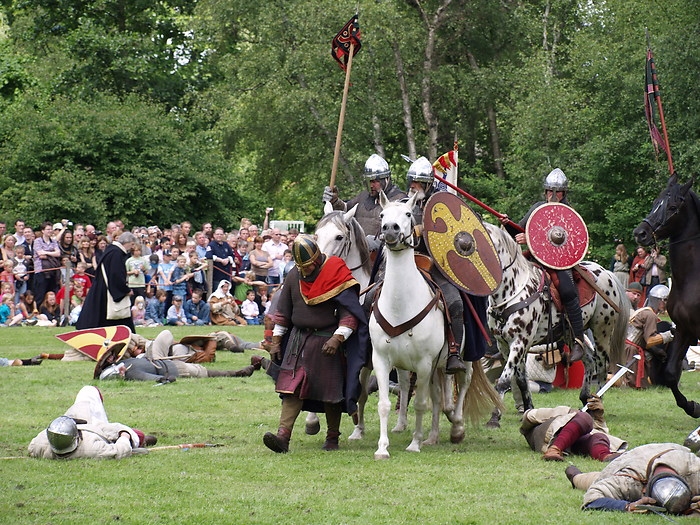 Figure 7. Duke Godfrey´s arrest, during the re-enactment of the Battle of Vlaardingen on 14/15 June 2008. Photo: Rene Kuysten. The reconciliation between Adelbold and Dirk is one of the last historical events recorded by Thietmar, who died on 1 December 1018. His chronicle ends with a few items from October 1018. Therefore, peace must have been settled within two months after the battle. Both Thietmar and Alpertus state that the rapprochement came about with the help of Duke Godfrey. In fact, the negotiations started immediately after the battle, during Godfrey’s captivity in Vlaardingen. Alpertus says that, after his victory, Dirk fell down on his knees before the duke, begging him to intercede for him. He feared that the emperor and the bishop would demand compensation for the bloodshed. After Godfrey had agreed to do what he could, he was released from his imprisonment, but he had to leave some of his men behind as hostages. Nothing is known about the arrangements that the opposing parties made. Henderikx supposes that Dirk III had to make promises to the bishop of Utrecht and that he even had to cede territories. This would be strange, because Dirk emerged as victor of the battle. In the same study, Henderikx suggests that after the Battle of IJsselmonde in 1076, in which a bishop of Utrecht was also defeated by a count of Holland, a settlement was made that was favourable to the victor. (32) That sounds more logical, and therefore it is likely that Dirk III in 1018 had to make some concessions in order to obtain the reconciliation, but concessions too were made on their part by the bishop and the emperor. A concession by Dirk may have been the donation of three farms to Bishop Adelbold, “ad satisfactionem”, mentioned in two charters from 1028 and 1050. (32a) Perhaps the bishop and the emperor promised to leave the count alone. In any event, no more armed conflicts have been recorded along the banks of the Merwede for three decades after the Battle of Vlaardingen. Other readingsMany later writings refer to the Battle of Vlaardingen, but more briefly than the three contemporary chronicles. Some authors only give a short mention of Duke Godfrey fighting a war against Count Dirk in Frisia. The Annals of Elmare merely state “battle in Vlaardingen”. Other documents provide a little bit more. Anselmus’ Chronicle and the Necrology of Saint Lambert corroborate the contribution of the bishopric of Liege to the imperial army. The Annals of Lobbes and the Necrologies of Merseburg and of Weissenburg name several participants unmentioned in earlier sources. The Vita Balderici tells of the preparations for the battle, and mentions a blood relationship between Bishop Balderic and Count Dirk III. Sigebert of Gembloux gives a rather extensive account of the Battle of Vlaardingen in his Chronica. He wrote almost a century after the date, and bases his chronicle on numerous earlier documents. He depicts the course of the events in 1018 somewhat differently from the early 11th-century sources. It seems as if Sigebert mixed up the years 1005 and 1018, because he claims that in 1018 Count Dirk III fought the Frisians to avenge the death of his father, and that Duke Godfrey attacked Dirk in that same year. However, from Thietmar’s contemporary report it is clear that the conflict between Dirk and the Frisians had already been settled in 1005: the Frisians were subdued, and in 1018 they fought on the count’s side. The remainder of Sigebert’s story does agree with the contemporary sources: Duke Godfrey acted at the emperor’s orders, and the tide was turned turn when someone shouted ‘flee, flee’. At the end, the Frisians killed many opponents and the duke was captured. Sigebert’s Chronica contains many errors and inaccuracies, so it would be best to ignore this source altogether. (33) However, in the Middle Ages Sigebert was held in high esteem, and his work was copied by many other authors. In order to understand how certain historical misconceptions arose, Sigebert’s work must be considered. Among the works relying on Sigebert are the Annals of Park, which render the story of Vlaardingen even more dramatic by describing the voice yelling ‘flee, flee’ as coming from the heavens. Rupert of Deutz also repeats part of Sigebert’s account. Furthermore, Rupert says that many warriors were killed on both sides. He attributes an important role to Bishop Wolbodo of Liege, Balderic’s successor, in orchestrating the negotiations after the battle. A century later, this was copied almost word for word by Reinerus in his Vita Wolbodonis. However, in the three contemporary sources Duke Godfrey is the negotiator and Wolbodo is not mentioned at all. Sigebert’s version of the events in Vlaardingen, and many other parts of his chronicle, were copied almost word for word into the Annals of Egmond (c. 1120), and subsequently into the Egmond Chronicle (c. 1270). Apparently, the Egmond monks did not have any historical records of their own for 1018, and they were not aware of the works of Thietmar and Alpertus nor of the Cambrai Chronicle. Thus, Sigebert formed the basis for much of Dutch historiography in the Middle Ages and in subsequent centuries. Johannes de Beke
In about 1346, Johannes de Beke completed his Chronographia, a history of the bishops of Utrecht and the counts of Holland. Beke’s account of the events in the year 1018 differs considerably from the contemporary sources: he describes not one, but three battles in that year.
According to the Chronographia, the battle on 29 July resulted in heavy losses for both parties, not only among the attackers but also on the side of Count Dirk III. Beke was commissioned by the bishop of Utrecht, so perhaps he tried to make the defeat look less embarrassing. He mentioned only Bishop Adelbold as the count’s opponent; the emperor, Duke Godfrey and the other bishops do not figure in his tale, nor does he mention Adelbold’s ignominious retreat before the end of the battle. Beke’s view of the cause of the battle of 29 July, is totally different from what the contemporary sources tell us. In his account the battle was a direct consequence of an earlier clash between Bishop Adelbold of Utrecht and the count of Holland. The bishop had already attacked Dirk III, on 11 July 1018, because the count had seized territories at Bodegraven, which the bishop had given in fief to another Dirk, nicknamed Bavo (son of Bave). The bishop lost the Battle of Bodegraven and he wanted revenge. (34) Apart from Beke’s Chronographia, two other sources support the possibility of military activities earlier in 1018. Thietmar says that Dirk III had repeatedly killed Adelbold’s warriors, and the Vita Balderici mentions war and revolt initiated by the same count. This does point to earlier hostilities, but not necessarily to one big battle. The 19th-century German historian Hirsch considered Beke’s coverage of the events in 1018 to be reliable. However, since Hirsch the idea of a battle on 11 July 1018 has been criticised. Oppermann suggests that it was a fabrication by Johannes de Beke, since the extensive contemporary reports about the year 1018 mention only one battle. Van Tuyl argues that Dirk III did indeed usurp the benefice near Bodegraven, but that this must have happened after 1018. Halbertsma also suggested that the hostilities near Bodegraven should be placed later in the 11th century. (35) A final argument against a earlier battle in July 1018, comes from Thietmar and the Vita Balderici. These sources state that the Vlaardingen expedition was initiated in April 1018 in Nijmegen, and that it was a major operation which took months of preparation. It would be illogical if one of the key players would wage war against Dirk III on his own account only weeks before the big day. It must be concluded that the idea of an earlier battle at Bodegraven that caused the Battle of Vlaardingen, was made up by Beke. In Beke’s defence, it should be said that his only sources were Sigebert of Gembloux, and the Dutch chronicles based on Sigebert. Like the Egmond monks, Beke was probably unaware of Alpertus, Thietmar and the Cambrai Chronicle. (36) The idea of a battle in Bodegraven may have come from a false charter, dated 2 May 1064 but actually drawn up in the 12th century. The charter says that Dirk Bavo was expelled from his fief at Bodegraven by Count Dirk; it does not give a date, nor does it specify which Count Dirk was involved. (37)
Beke may have taken the date of the first battle from the Necrology of Merseburg, which records on 11 July that “Godiza was killed, together with many others”. This entry in the necrology must be an error, because the same is recorded under 30 July, probably referring to the battle of 29 July 1018.
(38)
The possibility of a fight at Bodegraven at a later date cannot be excluded. Van Tuyl assumes that this was indeed the case, and that Dirk III was the count of Holland involved.
(39)
Kuiken is even more specific, and argues that it must have been before 1021. This argument is based on another false charter, the Memoriale Adelboldi.
(40)
If there was a Battle of Bodegraven, the date remains uncertain: it may also have been during the regime of Count Dirk IV.
(41)
In the Chronographia Beke describes even a third battle, which took place shortly after the one on 29 July. After his second victory over Bishop Adelbold, Count Dirk III attacked the Frisians. Beke says that the emperor ordered Duke Godfrey to assist Dirk. The Frisians won this battle: Dirk’s army fled after hearing the well known words ‘flee, flee’. Again, Beke presents a tale that does not comply with the oldest chronicles. In this case, it’s not so much his fault, but that of earlier historiographers for misinterpreting their sources. It started with Sigebert of Gembloux, who mixed events from the year 1005 into the battle of 1018. According to Sigebert, Dirk III fought the Frisians to avenge his father, and he was himself attacked by Duke Godfrey. This version was copied into the Annals of Egmond, subsequently into the Egmond Chronicle, and from there into the Verse Chronicle of Holland (Rijmkroniek van Holland), composed between 1280 and 1282, and not to be confused with Klaas Kolyn’s Rymchronyc, which appeared four centuries later. In the Verse Chronicle of Holland, things have been twisted again: it says that in 1018, Dirk III attacked the Frisians and lost the battle, despite the support of Emperor Henry and Duke Godfrey.
Eventually, Johannes de Beke was confronted with two conflicting versions: the Egmond Chronicle and the Verse Chronicle. It seems as if he has tried to carry it off by presenting the two versions as two separate battles: one on 29 July, and another later that year. It was Beke’s invention that Dirk’s attack against the Frisians was inspired by haughtiness, after his two victories on 11 and 29 July. The Lord punished him for that.
There is another 14th century source, the Bella campestria, which describes the battles of 11 and 29 July, but not the third battle in 1018. This document and the Chronographia stem from the same period, and they contain several identical phrases, so one must be (at least partially) based on the other. Perhaps Johannes de Beke was also the author of the Bella campestria. (42) Vlaardingen or Dordrecht?The Battle of Vlaardingen must have taken place within or near the town, since the medieval sources mention only Vlaardingen as the location of the hostilities. (43) Furthermore, the town was the headquarters of Dirk III, so it is logical that the emperor directed his expedition this way. Despite these clear indications, 18th and 19th century historians stubbornly maintained that Dordrecht, not Vlaardingen, must have been the scene of action. The ‘Battle of Dordrecht’ can be found among several historians from that era, and it is still suggested by the odd modern historian. (44) This hypothesis is untenable, not only because the sources about the battle in 1018 mention only Vlaardingen and not Dordrecht, but also because other data indicate that Dordrecht in the early 11th century was merely the name of a small river. There was no settlement of any significance, and certainly no castle. The name of the place first appeared halfway during the 11th century, in the report of the assassination of Count Dirk IV (1049), (45) and in a charter by King Henry IV (1064), which mentions ”Thuredrith cum capella noviter constructa”: a newly built chapel in Dordrecht. (46) Although this charter is false (it was actually written in the 12th century), its geographical specifications may be reliable. This could mean that a few decades after 1018, a small church was founded in Dordrecht. (47) However, no military stronghold is mentioned anywhere. Only after the floods of the mid-12th century, which dramatically altered the flow of the rivers, would the town acquire some importance. After 1150, Count Floris III established a toll in Dordrecht, and gradually it became the major town in the county of Holland. (48) But that was long after 1018. Excavations in Dordrecht’s town centre, carried out between 1968 and 1971, did not yield any evidence for an 11th-century settlement. (49) In Vlaardingen, on the other hand, various archaeological discoveries have proven the existence of a relatively important settlement in the early 11th century. Remains of a farmstead, laid out around 1000 AD, were found 20 years ago. (50) In 2002, a medieval graveyard was discovered at the church hill in Vlaardingen. It contained the remains of people who had died around the year 1050 and who had lived in rather luxurious circumstances. This indicates that the elite of the time resided in Vlaardingen. (51) The geo-physical findings, mentioned above, may be an indication that a castle stood on the church hill in the 11th century. This latter theory has not been definitely proven, but even without it, there are enough reasons to state that the battle of 1018 did indeed take place in Vlaardingen and not in Dordrecht. Jansen says: “Nothing justifies the presumptions that the events in 1018 took place at Dordrecht. Dordrecht did not exist at that time”. Other modern historians also relegate the stories about Dordrecht to the realm of fiction. (52) Why has Dordrecht been considered the location of the Battle of Vlaardingen for so long? It was Poelman, again, who discovered the origin of this misconception in the forged Rymchronyk. Klaas Kolyn rhymed that Dirk III founded a fortification and a village along the Merwede, that he named the settlement ‘Dordrecht’, and that the famous battle in 1018 was fought on that location. The historian Jan Wagenaar believed this story, and invented the year 1015 for the founding of the town of Dordrecht. (53) Subsequently, Wagenaar has been followed by many colleagues. (54) The fact that the names of the rivers have changed over time has contributed to the confusion. In the Middle Ages, the name ‘Merwede’ was applied for the stretch of river from Woudrichem all the way to the North Sea. Today, only the first part is called Merwede; the section from Dordrecht towards IJsselmonde is now known as ‘de Noord’ and the final part is called the New Maas. (55) Nowadays, people associate ‘Merwede’ with Dordrecht, but a thousand years ago, the settlement Vlaardingen was really situated along the Merwede, on the shipping route from Tiel to the North Sea. In 1018, the imperial fleet sailed along this route towards the castle of Dirk III, in Vlaardingen. Comets in 1018Major battles are often accompanied by cosmic phenomena. The most famous example must be Halley’s Comet, on the eve of the Battle of Hastings (1066). Comets also appear in the reports about Vlaardingen: one before the battle of 29 July 1018, and one shortly thereafter. The first comet had an elongated shape, like a joist, and was visible for a long period: almost four months. It is mentioned in the Cambrai Chronicle. The account has been copied (under the year 1017) by Sigebert and in the Annals of Egmond and of Cologne. An independent record can be found in the Annals of Quedlinburg. The exact dates of this comet are unknown, but it is certain that it preceded the battle. The Annals of Quedlinburg explicitly associate the comet with the Battle of Vlaardingen: “it heralded the great devastations by Dirk”. The second comet followed a few days after the battle, and was visible for two weeks. It appeared in the Plough constellation, and was described by Alpertus and Thietmar. This same comet was observed in Ulster and even in China, Japan, and Korea. The oriental sources give 3rd or 4th August as the starting date, and the northern sky (where the Plough stands) as its location. (56)
Since this second comet first appeared after the battle, it cannot be considered an omen for the events in Vlaardingen. It may have foretold another political shift: in 1018, when Cnut the Great, king of England, acquired the Danish throne. An association between the comet and King Cnut is suggested by the images on an Anglo Saxon coin from that period. It’s a silver penny, minted in Norwich between 1017 and 1023. King Cnut appears on the front, with a comet-like shape to his right.
(57)
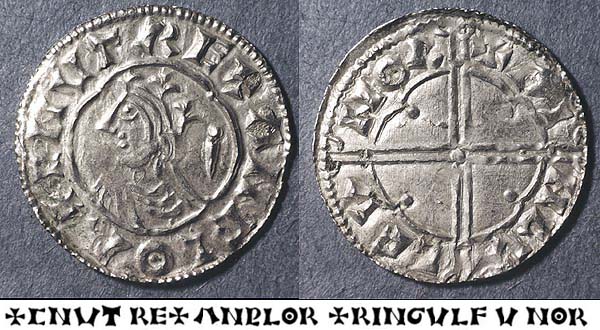 Figure 8. Anglo Saxon penny with a portrait of King Cnut the Great and, possibly, the comet of August 1018. Apart from these comets, Alpertus and Thietmar both mention a solar eclipse at Easter in the year 1018. Thietmar also mentions a flock of birds that gathered on the spot where the battle would take place and that viciously attacked each other, thus predicting the violence that was to come. Alpertus tells about more miraculous events that occurred after the battle: the bodies of the victims that had been thrown into the water were not touched by the wild animals. Even five months afterwards, nine corpses were found on the river bank, un-decayed. The significance of the Battle of VlaardingenThe Battle of Vlaardingen can be considered as the starting point for the independent county of Holland. In 1018, in Vlaardingen, Dirk III demonstrated that he would not be told what to do by any overlords. Later in the 11th century, German kings and emperors, passionately supported by the bishops of Utrecht, made further attempts to subdue the counts of West Frisia. In the years 1070 - 1076 they almost succeeded when Duke Godfrey ‘the Hunchback’ and Bishop William drove the young Count Dirk V out of Frisia. However, with a little help from the Flemish Count Robert, Dirk managed to eliminate the duke and regain his county. (58) Matters were finally settled at the Battle of IJsselmonde, on 8 June 1076. Another important but unknown Dutch battle … Notes1 - Thanks to Tim de Ridder (town archaeologist of Vlaardingen) for proof reading the manuscript of the original Dutch article.I am grateful to Bryan Betts, Benedict Coffin, Gordon Monks, Georgina Riall, and Alistair Streek (all members of The Vikings, www.vikingsonline.org.uk) for proof reading and improving the English translation. (back) 2 - A list of all medieval sources consulted is presented at the end of this article. A complete overview of all Latin texts, with Dutch translations, is in preparation (Nieuwenhuijsen 2011). (back) 3 - About the wilderness regality: OHZ 55 (see also Bult, 1986, p. 118); Arnulf’s death: Cambrai Chronicle (the year 993 is first mentioned in the Annals of Egmond); the troubles in 1005: Thietmar; the Frisians liable to pay taxes: Alpertus. (back) 4- Poelman (1910). With thanks to Henk ’t Jong, for drawing my attention to this study. (back) 5 - There are several theories about the identity of the falsifier; see the Klaas Kolyn website. (back) 6 - Van Loon (1745, p. 287). (back) 7 - Wagenaar (1749, p. 140). (back) 8 - About the origin and the unmasking of the falsification: de Bonth (1993). (back) 9 - Blok (1986, p. 170); Halbertsma (2000, p. 195); Henderikx (1997, p. 115); Hirsch (1875, p. 98); Hoppenbrouwers (2002, p. 121); Janse (2002, p. 72); Jansen (1982, p. 282); Klein (2004, p. 43). Verkerk (1997, p. 102) even suggested that Dirk III had a formal right to levy tolls, and that all the fuss arose when he raised the tariffs on his own authority. (back) 10 - Henderikx (1997, p. 116-117). (back) 11 - Henderikx (1997, p. 120); Broer (2000, p. 378). The fact that Count Dirk collected taxes from the locals for reclamations is mentioned only briefly by Alpertus. (back) 5 - Reuter (1991, p. 308). (back) 13 - Werner (1991, p. 382 - 384). (back) 14 - Remarkably, the participation and death of troops from Cambrai is mentioned by Thietmar, but not in the Cambrai Chronicle. (back) 15 - De Graaf (1996, p. 100) caused some confusion when he stated that “Thietmar says that in the salty tideways and troughs, more than 900 men fell, and that were, according to the bishop [Thietmar of Merseburg] who did not know much about it, more than three legions”. However, Thietmar does not mention any tideways or troughs or similar terms, and the number 900 cannot be found anywhere in his chronicle. Perhaps, de Graaf misinterpreted the word ‘nocentem ’ in Thietmar’s report. (back) 16 - Website Wikipedia, Dutch version - ‘legioen’. (back) 17 - Van Bentum (2006, p. 10). (back) 18 - Verbruggen (1977, p. 6 ff). The Battle of Hasting (1066), with an estimated 10.000 men per side, was extraordinary (Bachrach, 1985). See Murray (1978) about the ‘arithmetical mentality’ in the Middle Ages. For more military data: Halsall (2003, p. 119 ff); van der Tuuk (2008, p. 144). (back) 18a - Egil’s Saga, translated by Green (1893, p. 190). (back) 19 - Verbruggen (1977, p. 10); Werner (1991, p. 388). (back) 20 - De Graaf (1996, p. 42). (back) 21 - Alpertus uses the word ‘fossae’. There has been quite a discussion about the correct translation. According to Hoek (1973a, p. 79) it means ditches, while van Rij (1999, p. 79) and also de Graaf (1996, p. 102) think that dykes were meant. Finally, Heinsbroek (2004; in particular Willem van Bentum’s contribution to this article) and de Ridder (2006) have shown convincingly, that the correct translation must be ‘ditches’ or ‘canals’, and not ‘dykes’. (back) 22 - Hoek (1973a). (back) 23 - De Graaf (1996, p. 102); Halbertsma (2000, p. 199); de Ridder (2001, p. 44). (back) 24 - De Graaf (1996, p. 96 - 102). (back) 25 - De Ridder (2006). (back) 26 - De Ridder & van Loon (2007); Hoek (1973b). (back) 27 - Roest & van Loon (2007). (back) 28 - De Ridder (2006). (back) 29 - De Ridder (pers. comm.). (back) 30 - Köpke & Dümmler (1876, p. 91 ff). (back) 31 - Van der Tuuk (2008); Anglo-Saxon Chronicle. (back) 32 - Henderikx (1997, p. 120 and note 110). (back) 32a - OHZ 76 and 81. About the authenticity of the 1050 charter: Broer (2000, p. 42 and 239 ff). Hirsch (1875, p. 104) considers the three farms ”a small compensation”. The 1050 charter specifies the location of the three farms in Teisterbant; therefore, van Winter (1981, p. 63) and Broer (2000, p. 356) assume that the donator must have been Count Dirk of Hamaland, not Dirk III of Frisia. However, this Dirk of Hamaland did not have any conflicts with the bishop that had to be pacified. It is possible that Dirk III of Frisia had possessions in Teisterbant, because his ancestors, a century earlier, had been counts there. (back) 33 - Already in 1892, Wattenbach condemned the chronicle as “almost worthless”. (back) 34 - The Bella campestria mention 11 July. Beke’s Chronographia says June, but according to Bruch (1973, p. 77) this must be a writing error, since Beke also says that 19 days later the battle of 29 July took place; 19 days means the 19th day thereafter, counting 11 July as day one. (back) 35 - Hirsch (1875, p. 100); Opperman (1933, p. 85); van Tuyl (1998, p. 29, 32); Halbertsma (2000, p. 138). According to de Graaf (1996, p. 103 and note 160), Dirk Bavo appeared years later, so there could have been no conflict over his territories in 1018. This is a weak argument, because nothing is known about this Dirk and his life. (back) 36 - Bruch (1973, p. XL). (back) 37 - OHZ 86. (back) 38 - Althoff & Wollasch (1983, p. XXVII). (back) 39 - Van Tuyl (1998, p. 27 and 32). (back) 40 - Kuiken (2004, p. 244); OHZ 73. (back) 41 - De Graaf (1996, p. 103); Halbertsma (2000, p. 138). (back) 42 - Muller (1888, p. 103). (back) 43 - Alpertus, Anselmus, Vita Balderici, Annals of Elmare and Necrology of Saint Lambert in Liege. (back) 44 - Kluit (1780, p. 70); van der Aa (1858, the biographies of Dirk III and of Bishop Adelbold); Hirsch (1875, p. 96, about Vlaardingen: “den Punkt des Angriffs und der Schlacht von 1018 kann es unmöglich gewesen sein”); Vanderkindere (1902, p. 93); Klein (2004), but without any substantiation. See also the studies cited by Poelman (1910), and three English historical books, dated 1830, 1841, and 1922, mentioned at www.geerts.com . (back) 45 - The assassination in 1049 is first mentioned in the Annals of Egmond, written around 1120. (back) 46 - OHZ 86. (back) 47 - Henderikx (2005, p. 54). (back) 48 - Frijhoff & van Herwaarden (2000, p. 19). (back) 49 - Jansen (1979, p. 27). (back) 50 - Ter Brugge (1992); Defilet & de Ridder (2001). (back) 51 - Groen & de Ridder (2007). (back) 52 - Jansen (1979, p. 15); Algra & Algra, (1956/1978, p. 66); Frijhoff & van Herwaarden (2000, p. 15). (back) 53 - Poelman (1910, p. 367). Later, Jansen (1979, p. 15) also named Klaas Kolyn as the inventor of the Dordrecht myth, but without referring to Poelman. (back) 54 - Van Loon (1745, p. 284 ff); Wagenaar (1749, p. 140); See also note 44. (back) 55 - Henderikx (1997, p. 104 and note 19). See also Ramaer (1899, p. 167) about the name ‘Merwede’. (back) 56 - Website Annals of Ulster, AD 1018; Ho Peng Yoke (1962, numbers 360 and 362). (back) 57 - Website Faintich. (back) 58 - Dirk and Robert laid a plot to kill the duke; he was assassinated in or near Vlaardingen, in February 1076 (Nieuwenhuijsen, 2007). (back)
Figure 9. On the corner of Vlaardingen’s town hall stands a statue of Dirk III. The town hall is built opposite the church, on the ancient central mound of Vlaardingen. Probably, the real Dirk III had walked here - a thousand years ago. Photos: Kees Nieuwenhuijsen. ReferencesThe primary sources (editions of original texts), literature (historical studies), and websites are presented below in three separate lists. Some references contain both an edition of a manuscript and a research report. For easy searching, such references have been included in both lists. Thus, van Rij’s edition and study of Alpertus van Metz has been included among the primary sources under the letter A (Alpertus) and also among the studies, under the letter R (van Rij).
More and more sources, journals and books appear on the Internet. Including all digital versions would require constant updating. Therefore, web links have only been included in the present list, if no printed version is available. The latest digital versions can be found by searching the websites
books.google.com and
www.archive.org
Primary sourcesAll editions give the complete original text in Latin, except where noted.
Literature
WebsitesThe websites have been consulted in December 2010.
Document historySeptember 2010 - Original article (in Dutch) published in Terra Nigra.October 2010 - Web edition in Dutch. January 2011 - Web edition in English, version 1.0. February 2011 - Web edition in English, version 2.0. Added: Reference to Egil’s Saga; reclamations as cause of the conflict; compensation by Dirk III. |
The Battle of Vlaardingen (1018)
|
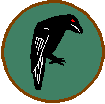
e-mail: kees.nieuwenhuijsen@tip.nl
home page: www.keesn.nl
| If you want to copy any pictures or texts from this website, please send me an e-mail |
